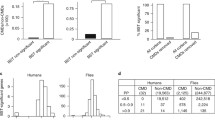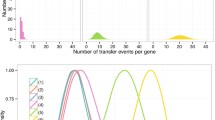Abstract
Previous studies have shown that recombination between allelic sequences can cause likelihood-based methods for detecting positive selection to produce many false-positive results. In this article, we use simulations to study the impact of nonallelic gene conversion on the specificity of PAML to detect positive selection among gene duplicates. Our results show that, as expected, gene conversion leads to higher rates of false-positive results, although only moderately. These rates increase with the genetic distance between sequences, the length of converted tracts, and when no outgroup sequences are included in the analysis. We also find that branch-site models will incorrectly identify unconverted sequences as the targets of positive selection when their close paralogs are converted. Bayesian prediction of sites undergoing adaptive evolution implemented in PAML is affected by conversion, albeit in a less straightforward way. Our work suggests that particular attention should be devoted to the evolutionary analysis of recent duplicates that may have experienced gene conversion because they may provide false signals of positive selection. Fortunately, these results also imply that those cases most susceptible to false-positive results—i.e., high divergence between paralogs, long conversion tracts—are also the cases where detecting gene conversion is the easiest.





Similar content being viewed by others
References
Anisimova M, Bielawski JP, Yang Z (2001) Accuracy and power of the likelihood ratio test in detecting adaptive molecular evolution. Mol Biol Evol 18:1585–1592
Anisimova M, Bielawski JP, Yang Z (2002) Accuracy and power of Bayes prediction of amino acid sites under positive selection. Mol Biol Evol 19:950–958
Anisimova M, Nielsen R, Yang Z (2003) Effect of recombination on the accuracy of the likelihood method for detecting positive selection at amino acid sites. Genetics 164:1229–1336
Arbiza L, Dopazo J, Dopazo H (2006) Positive selection, relaxation, and acceleration in the evolution of the human and chimp genome. PLoS Comput Biol 2:288–300
Benovoy D, Drouin G (2009) Ectopic gene conversions in the human genome. Genomics 93:27–32
Bielawski JP, Yang Z (2003) Maximum likelihood methods for detecting adaptive evolution after gene duplication. J Struct Funct Genomics 3:201–212
Birtle Z, Goodstadt L, Ponting C (2005) Duplication and positive selection among hominin-specific PRAME genes. BMC Genomics 6:120
Chen JM, Cooper DN, Chuzhanova N, Ferec C, Patrinos GP (2007) Gene conversion: Mechanisms, evolution and human disease. Nat Rev Genet 8:762–775
Des Marais DL, Rausher MD (2008) Escape from adaptive conflict after duplication in an anthocyanin pathway gene. Nature 454:762–765
Drouin G, Prat F, Ell M, Clarke GD (1999) Detecting and characterizing gene conversions between multigene family members. Mol Biol Evol 16:1369–1390
Gerton JL, De Risi J, Shroff R, Lichten M, Brown PO, Petes TD (2000) Inaugural article: global mapping of meiotic recombination hotspots and coldspots in the yeast Saccharomyces cerevisiae. Proc Natl Acad Sci U S A 97:11383–11390
Hahn MW, Demuth JP, Han SG (2007a) Accelerated rate of gene gain and loss in primates. Genetics 177:1941–1949
Hahn MW, Han MV, Han SG (2007b) Gene family evolution across 12 Drosophila genomes. PLoS Genet 3:1–12
Han MV, Demuth JP, McGrath CL, Casola C, Hahn MW (2009) Adaptive evolution of young gene duplicates in mammals. Genome Res 19:859–867
Hill RE, Hastie ND (1987) Accelerated evolution in the reactive centre regions of serine protease inhibitors. Nature 326:96–99
Hughes AL, Nei M (1988) Pattern of nucleotide substitution at major histocompatibility complex class I loci reveals overdominant selection. Nature 335:167–170
Li W-H (1997) Molecular evolution. Sinauer Associates, Sunderland, MA
Mondragon-Palomino M, Gaut BS (2005) Gene conversion and the evolution of three leucine-rich repeat gene families in Arabidopsis thaliana. Mol Biol Evol 22:2444–2456
Muse SV, Gaut BS (1994) A likelihood approach for comparing synonymous and nonsynonymous nucleotide substitution rates, with application to the chloroplast genome. Mol Biol Evol 11:715–724
Nei M, Gojobori T (1986) Simple methods for estimating the numbers of synonymous and nonsynonymous nucleotide substitutions. Mol Biol Evol 3:418–426
Nielsen R, Yang Z (1998) Likelihood models for detecting positively selected amino acid sites and applications to the HIV-1 envelope gene. Genetics 148:929–936
Nielsen KM, Kasper J, Choi M, Bedford T, Kristiansen K, Wirth DF, Volkman SK, Lozovsky ER, Hartl DL (2003) Gene conversion as a source of nucleotide diversity in Plasmodium falciparum. Mol Biol Evol 20:726–734
Santoyo G, Romero D (2005) Gene conversion and concerted evolution in bacterial genomes. FEMS Microbiol Rev 29:169–183
Sawyer S (1989) Statistical tests for detecting gene conversion. Mol Biol Evol 6:526–538
Scheffler K, Martin DP, Seoighe C (2006) Robust inference of positive selection from recombining coding sequences. Bioinformatics 22:2493–2499
Semple C, Wolfe KH (1999) Gene duplication and gene conversion in the Caenorhabditis elegans genome. J Mol Evol 48:555–564
Shriner D, Nickle DC, Jensen MA, Mullins JI (2003) Potential impact of recombination on sitewise approaches for detecting positive natural selection. Genet Res 81:115–121
Slightom JL, Blechl AE, Smithies O (1980) Human fetal G gamma- and A gamma-globin genes: Complete nucleotide sequences suggest that DNA can be exchanged between these duplicated genes. Cell 21:627–638
Wong WS, Yang Z, Goldman N, Nielsen R (2004) Accuracy and power of statistical methods for detecting adaptive evolution in protein coding sequences and for identifying positively selected sites. Genetics 168:1041–1051
Yang Z (2007) PAML 4: Phylogenetic analysis by maximum likelihood. Mol Biol Evol 24:1586–1591
Yang Z, Nielsen R (2002) Codon-substitution models for detecting molecular adaptation at individual sites along specific lineages. Mol Biol Evol 19:908–917
Yang Z, Nielsen R, Goldman N, Pedersen AM (2000) Codon-substitution models for heterogeneous selection pressure at amino acid sites. Genetics 155:431–449
Yang Z, Wong WS, Nielsen R (2005) Bayes empirical Bayes inference of amino acid sites under positive selection. Mol Biol Evol 22:1107–1118
Zhang J, Nielsen R, Yang Z (2005) Evaluation of an improved branch-site likelihood method for detecting positive selection at the molecular level. Mol Biol Evol 22:2472–2479
Acknowledgments
We thank Mira Han for assistance and three reviewers for their insightful comments. This work was supported by a grant from the National Science Foundation to MWH (Grant No. DBI-0543586).
Author information
Authors and Affiliations
Corresponding author
Electronic supplementary material
Below is the link to the electronic supplementary material.
Rights and permissions
About this article
Cite this article
Casola, C., Hahn, M.W. Gene Conversion Among Paralogs Results in Moderate False Detection of Positive Selection Using Likelihood Methods. J Mol Evol 68, 679–687 (2009). https://doi.org/10.1007/s00239-009-9241-6
Received:
Revised:
Accepted:
Published:
Issue Date:
DOI: https://doi.org/10.1007/s00239-009-9241-6




